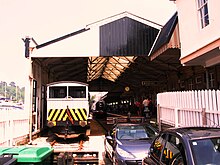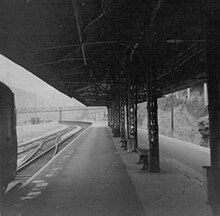Kingswear railway station
Kingswear | |
|---|---|
| Station onheritage railway | |
 | |
| General information | |
| Location | Kingswear,South Hams England |
| Coordinates | 50°20′56″N3°34′21″W/ 50.34882°N 3.57253°W |
| Grid reference | SX881510 |
| Operated by | Paignton and Dartmouth Steam Railway |
| Managed by | South Devon Railway |
| Platforms | 2 |
| History | |
| Opened | 1864 |
| Original company | Dartmouth and Torbay Railway |
| Pre-grouping | Great Western Railway |
| Post-grouping | Great Western Railway |
| Key dates | |
| 30 December 1972 | Preserved |



Kingswear railway stationis the terminus of theDartmouth Steam Railway,aheritage railwayinDevon,England. It is situated in the centre ofKingswear,on the shores of theRiver DartoppositeDartmouth.
The station has level access to the street and is adjacent to Yacht Club Hotel, the pontoon for theDartmouth Passenger Ferry,and theslipwayof theDartmouth Lower Ferry.
History
[edit]The railway toKingswearwas built by theDartmouth and Torbay Railway,opening on 16 August 1864.[1]The original aim had been to reach Dartmouth butthe railway station in that town,which sold train tickets and processed parcels but lacked platforms and trains, was only ever reached byferry.The railway company opened the Yacht Club Hotel at the southern end of the station in 1866, intended mainly for passengers on the ocean-going ships that called at Dartmouth at that time.
Goods trains were run to Kingswear from 2 April 1866 and these proved to be of great importance, not just in shipping goods out by sea, but also in carrying coal landed at Kingswear to thegas worksat Hollacombe betweenPaigntonandTorquay railway stations.
The Dartmouth and Torbay Railway was always operated by theSouth Devon Railway Companyand was amalgamated with it on 1 January 1872. This was only short lived as the South Devon Railway was in turn amalgamated into theGreat Western Railwayon 1 February 1876. The line had been built using the7 ft(2,134 mm)broad gauge,but on 21 May 1892 was closed for the weekend to be converted to4 ft8+1⁄2in(1,435 mm)standard gauge;the 28 men responsible for the work in the area were accommodated in the station'sgoods shed,which was situated on the river side of the main stationtrain shed.New sidings were laid in 1894 and asignal boxopened to control the trains; the following year more sidings were laid on land reclaimed from the river north of the station and a long footbridge constructed over the station to carry a footpath to the shore of the river.
The railway originally approached the station across three creeks on low timber viaducts. Those at Longwood and Noss being demolished after the line was moved inland around the creeks on 20 May 1923, and Hoodown Viaduct, just outside the station, was replaced by a double-track steel structure in 1928. This and the provision of a largerturntableenabled larger locomotives to work through to Kingswear. The platform was extended in 1929 to 850 feet (259 m) which allowed longer trains too.
The Great Western Railway wasnationalisedintoBritish Railwaysin 1948. The signal box was given a new lever frame in 1960 but the run down of services soon commenced. The wharf was closed to freight traffic on 4 May 1964[1]and ordinary goods traffic was withdrawn on 14 June 1965.[2]
Except for peak season trains, most services from 18 April 1966 operated as a shuttle service fromPaignton;Sunday trains were withdrawn from 24 September 1967, although some were run during the summer of the following year.[1]On 20 October 1968 the signal box was closed and the following month it was formally proposed that the line from Paignton should be closed entirely but instead, on 30 December 1972, the line was sold to the Dart Valley Light Railway plc, which operated a nearbyheritage railwayatBuckfastleigh.The Royal Dart Hotel was sold by the Dart Valley Railway into private hands in 1979, the revenue from this and other property sales going a long way to repay the £275,000 paid to British Rail for the line.
The second platform track was reinstated in 1976, points around the station being controlled by local ground frames. Since 1990 electric multiple aspect signals have been controlled from the signalling panel at Britannia Crossing.[2]
Description
[edit]The southern end of theplatformand tracks is covered by a rare wooden 100 feet (30 m)[1]train shed,with a more conventional canopy extending further along the platform. The entrance to the station opens onto the main platform within the train shed; trains stop further along the platform to the right to allow the locomotive to run around the train using the crossover at this end of the platform track. The bay platform does not have a locomotive release road and so is only used for occasional departures that have been shunted onto this line to free up the main platform for a second train.
The old goods yard between the station and the waterfront is now a car park and boat storage; the long footbridge at the north end of the station is not connected to the platforms but instead carry a footpath from the main road across to the waterfront. Another car park at the north end of the station is on the site of the turntable and carriage sidings. A few sidings have been retained opposite the platform and alongside the line towards Britannia Crossing, thelevel crossingthat leads down to theDartmouth Higher Ferryand is the site of the railway's signalling centre.

Services
[edit]A seasonal service of steam hauled trains operates to and fromPaignton.
| Preceding station | Following station | |||
|---|---|---|---|---|
| Greenway Halt | Dartmouth Steam Railway | Terminus | ||
| Ferry | ||||
| Terminus | Dartmouth Passenger Ferry | Dartmouth | ||
References
[edit]- ^abcdPotts, C R (1998).The Newton Abbot to Kingswear Railway (1844 - 1988).Oxford: Oakwood Press.ISBN0-85361-387-7.
- ^abOakley, Mike (2007).Devon Railway Stations.Wimbourne: The Dovecote Press.ISBN978-1-904349-55-6.
Further reading
[edit]- Beck, Keith; Copsey, John (1990).The Great Western in South Devon.Didcot: Wild Swan Publication.ISBN0-906867-90-8.
- Cooke, RA (1984).Track Layout Diagrams of the GWR and BR WR, Section 14: South Devon.Harwell: RA Cooke.
| This station offers access to theSouth West Coast Path | |
|---|---|
| Distance to path | 50 yards (46 m) |
| Next station anticlockwise | Churston12 miles (19 km) |
| Next station clockwise | Plymouth65 miles (105 km) |
